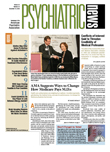Financial conflict of interest is a near inevitability in today's medical world, and if it cannot realistically be eliminated, then it must be managed to preserve the profession's credibility, Catherine DeAngelis, M.D., M.P.H., said at the annual meeting of the American Academy of Child and Adolescent Psychiatry (AACAP) in Chicago in October.
DeAngelis, a pediatrician and editor of the Journal of the American Medical Association, spoke to the group the day before it debated a review of its own policies on conflict of interest.
AACAP gave DeAngelis its Catcher in the Rye Humanitarian of the Year Award for her leadership on the increasingly important issue.
“Dr. DeAngelis has demanded that the medical community reexamine and reflect on conflicts of interest to assure transparency,” said AACAP President Robert Hendren, D.O., in a statement. “She continues to raise the bar on behalf of quality research being delivered to families.”
Everybody faces some conflict of interest—physicians, researchers, medical organizations, even journal editors who want to increase their publication's impact, subscriptions, and profits, said DeAngelis.
“Conflicts arise when there are differences between a physician's personal interests and the patient's interests,” she said.
Medicine is also under increased scrutiny from a skeptical citzenry and lawmakers, as recent high-profile incidents involving apparent conflicts of interest by physicians have shown. Responsibility may be widely distributed, but DeAngelis has no trouble spotting the elephant in the room.
Pharmaceutical and device manufacturers decided 15 years ago to shift dollars from science to marketing, “and that has too often led to increased dependence by researchers on industry funding, manipulation of clinical trials, suppression of results, delay of publication, and even deliberate lying,” she said. “Those outcomes arouse public concern and threaten the credibility of biomedical research.”
Nevertheless, the pharmaceutical companies have an essential place in medicine, she said, “and we must work with them.”
Doing so means starting with full disclosure by physicians of their financial ties to industry, although “disclosure is not enough,” she said. JAMA and 11 other major medical journals have also said that all clinical trials whose results they publish must have been formally entered in advance in a central clinical-trials registry. In cases where she suspects major violations of ethical boundaries or attempts to hide them, DeAngelis emphasized her willingness to call up officials at a researcher's university and suggest an inquiry (Psychiatric News, September 15, 2006).
At the same meeting, AACAP members discussed the second of their organization's three guidelines covering conflicts of interest in patient care and research settings, as well as for AACAP as an institution.
The first guideline, governing members' work with their patients, was approved in June, said AACAP President-elect Laurence Greenhill, M.D., in an interview with Psychiatric News.
The guidelines take the form of recommendations to members, alerting them to potential conflicts in their practices and asking them to evaluate those conflicts and disclose and discuss them with patients. Child and adolescent psychiatrists should “consider” not accepting gifts from pharmaceutical companies or distributing patient-information literature sponsored by them, according to the guidelines.
DeAngelis served on the panel that put together that statement, said Greenhill.
“She really educated us,” he said. “It took me a while to understand the issues, but I have already changed how I do things.” As an example, he said that he would no longer accept travel stipends from a drug manufacturer in the same year that he received a research grant from the company.
The second set of guidelines, on conflicts arising in research and academia, is not yet released publicly but is under review and due for approval in spring 2009, said Greenhill. A third statement will cover whether and how AACAP can accept industry funding.
“It is possible to work with private sources of funding, but disclose those sources and where the money goes,” Greenhill stated.
AACAP's “Guidelines on Conflict of Interest for Child and Adolescent Psychiatrists” is posted at<www.aacap.org/cs/root/physicians_and_allied_professionals/guidelines_on_conflict_of_interest_for_child_and_adolescent_psychiatrists>.▪
